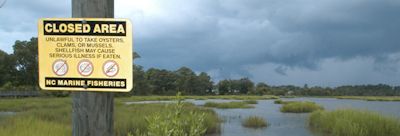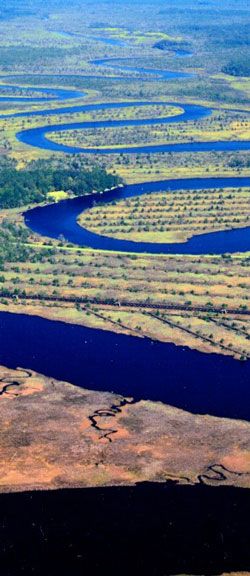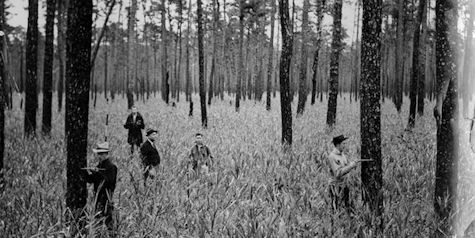Reprinted from the Tideland News
The N.C. Coastal Federation last week filed a Freedom of Information Act request with the Army Corps of Engineers seeking information about thousands of acres in the Hofmann Forest that appear to have been cleared, possibly for eventual conversion to agricultural use.
Supporter Spotlight
The federation’s request came as legal maneuvers continued in an effort to try to stall or stop N.C. State University’s sale of the 79,000-acre forest in Onslow and Jones counties to a private, Illinois-based agricultural corporation.
View Larger Map |
Todd Miller, executive director of the non-profit group in Ocean, filed the request one day after an “investor prospectus” surfaced that appeared to call into question assurances by the buyer, Hofmann Forest LLC, that if it buys the research forest from the NCSU Endowment Fund, it will maintain most of the forest for research and not convert it to agricultural, commercial and residential uses.
Opponents of the proposed $150 million sale contend that any significant development of the forest could dramatically affect water quality and wildlife throughout much of the state’s central coastal area.
The forest, which N.C. State has significantly controlled or outright owned and preserved since the 1930s, makes up a large percentage of the watershed for three key rivers — the White Oak, Trent and New — and is part of a much larger and increasingly rare woodlands ecosystem, linking the Croatan National Forest in Carteret and Craven counties to other forests at Camp Lejeune and Holly Shelter in Pender County.
Miller said last week that the Hofmann Forest land works as sort of a “kidney” for the region, as its vast, undeveloped acreage and countless trees and other plants soak up water and filter out pollutants before they reach coastal waters.
Supporter Spotlight
Although converting the forest to agricultural use would be somewhat better than urbanization, Miller said, such a conversion would require ditching the land to drain off water and the extensive use of nutrient-rich fertilizers that would run off into the rivers and eventually the sounds.
 Converting large tracts in the Hofmann Forest to agricultural or residential uses could have severe effects on water quality in the White Oak, Trent and New rivers. All are already experiencing problems from pollution. Photo: NCDENR |
In his FOI request, Miller said the prospectus states that, “‘As of Feb. 2013, 5,502 acres in the Forest have been clearcut and/or been prepped for reforestation. These areas could easily be converted to agricultural uses without having to go through the Corps of Engineers.”
Miller asked Dee Dee Fauser, the FOI Act officer in the Corp’s Wilmington District Office, for “any permits issued by your agency or documents, notes, records of phone conversations or any other affirmative authorizations that were issued since 1972 that permitted digging of ditches on this property and the conversion of wetlands to uplands.”
He also asked for documents that would show that sections of the forest are not subject to wetland regulations under the federal Clean Water Act and could be converted to agricultural uses without a permit from the Corps.
The prospectus also described developing up to two million square feet of commercial space and more than 10,500 homes, including a golf community, near Jacksonville, and converting as many as 50,000 acres from forest to cropland. It estimates the value of potentially converted farmland at $5,500 to $6,500 per acre. It also notes the potential for mineral excavation and gas exploration.
Although representatives of the LLC last week said the prospectus was put together months ago and the focus has since shifted to preserving the forest, Miller and others are skeptical. Miller noted that map in document is dated February 2013. “That’s not that long ago,” he said.
He and others point out that the document was put together to attract investors, who most likely would expect something from their investments other than ownership of forestland. Miller also noted that a tremendous portion of the forest is federally designated wetlands.
 The White Oak River starts in the Hofmann Forest and meanders in graceful loops toward Swansboro and the sea. |
Lawsuit Filed
A coalition of foresters, conservationists and others filed suit in September to require NCSU to study the potential environmental effects of the sale before the deal is completed. They say that such a review is required under state law before public land can be sold. A judge on Nov. 12 declined to issue an injunction to temporarily block the sale after questioning whether there was any specific proof that the buyer intended to develop Hofmann. The prospectus surfaced the next day. The court has not yet ruled on the university’s motion to entirely dismiss the suit.
John Eddy, a Jones County property owner and conservationist who is involved in the effort to stop the sale, said last week that he was disappointed in the judge’s decision not to grant the injunction.
“It’s hard to believe someone would spend $150 million and leave it (the land) sit, but the judge did not believe we proved irreparable harm and did not grant the injunction we sought,” he said. “The judge is still deciding whether our case should be dismissed based on lack of standing or other reasons.”
The one good thing that came out of the injunction hearing last week, Eddy said, was that the state Department of Justice conceded that the forest was public land.
Eddy, a co-plaintiff in the suit, is the son of the late Elmer Eddy of Swansboro, the so-called “White Oak River Trashman.” He is a civil and water resources engineer with undergraduate and master’s degrees from N.C. State. Although his father dedicated much of the last two decades of his life to literally removing trash from streams in and around Swansboro and the White Oak River, the son is focusing more on water quality, and believes the forest’s sale, without ironclad rules to stop its development, is potentially devastating.
“These waterways already have challenges related to water quality, as evidenced by fish kills and closed shellfish waters,” he said. “More intense land use reduces water quality and increases stormwater runoff. Stormwater runoff is the single largest source of water pollution.”
Eddy and the other plaintiffs insist that a state environmental review is essential, regardless of last week’s court ruling. In his view, the State Environmental Policy Act, or SEPA, includes two very broad categories that cover virtually every state action: Any action involving the expenditure of public money and ‘any action involving the use of public land.
“It is simply common sense that the sale of the largest state-owned tract of land in North Carolina and the largest research forest in the world to a private corporation is a use of public land,” Eddy said. “Also, in a common sense evaluation, it is clear that sale is the ultimate use of public land. It is being used to get money. The money would not flow if the land were not sold.
Barring any significant deed restrictions, the private owners of the Hofmann could develop the land to the highest uses allowed by local laws, he said. “Such use would clearly significantly affect the environment of this state,” Eddy said. “As such, the act of sale by the board of trustees would set into motion land use changes based on the recognized principle of highest and best use, which would not happen in the absence of a sale.
The purchase contract does not prevent significantly more intense land use on a large part of Hofmann Forest, according to Eddy. “Because Hofmann is so large, even moderate increases in land use intensity will negatively impact all coastal waters and communities downstream,” he said.
Water Issues
 J.V. Hofmann and class measuring pine in reed bed at Hofmann Forest, about 1937. Photo: NCSU Libraries. J.V. Hofmann and class measuring pine in reed bed at Hofmann Forest, about 1937. Photo: NCSU Libraries. |
The area already has its share of water-quality problems, Eddy added. In a 2007 assessment, the state noted that all of the saltwater miles and 44 percent of the freshwater portions of the White Oak River are plagued by high levels of bacteria that can permanently or temporarily close shellfish beds to fishing. Stormwater runoff is the main source of the bacteria. The New River and Neuse River are also impaired and for the same reasons.
“We all see manifestations of these water quality issues in fish kills and in closed shellfish waters,” Eddy said. “Sometimes waters are even closed to swimming. Do we want more of this?”
Officials with N.C. State University’s endowment board and the school’s natural resources council signed the agreement last month to sell the property to Hofmann LLC.
University officials have said that Hofmann Forest LLC was chosen as the buyer of the land specifically because of its stated intention to preserve the working forest and to continue to allow faculty and students to continue to do research there.
The deal has to close within 180 days of that agreement. The contract states that the new owners plan to sell easements to the military for training on about 70,000 acres. That, officials from the company and the school have said, is the main way the owners intends to profit from its purchase. Agricultural uses are not necessarily precluded in such easement agreements.
Onslow County officials said this week that they were closely watching the issue and studying the prospectus.
“We … plan to thoroughly review the document and consult with our military counterparts regarding all possible impacts of actions described,” county spokesman Todd Lyman said. “We continue to emphasize that the value of Hofmann Forest to the region, the state of North Carolina and national defense cannot be overstated…. That being said … we must be prudent in our review of possible Hofmann Forest uses and the inevitable impact on our residents.”







